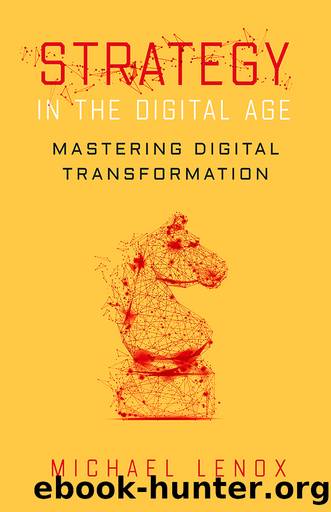Strategy in the Digital Age by Lenox Michael;

Author:Lenox, Michael;
Language: eng
Format: epub
Publisher: Stanford University Press
Published: 2023-04-15T00:00:00+00:00
Our discussion on appropriability further emphasizes that innovation does not occur in a vacuum. Innovation emerges out of a broader ecosystem of stakeholders including customers, suppliers, partners, and even competitors. The key is to position yourself to leverage your unique complementary capabilities and resources to ensure that you capture some of the innovationâs value. However, narrowly focusing on capturing as much of the gains from innovation for yourself as possible can be self-defeating, as it may discourage partners and stifle the very innovation necessary to continue to flourish. Often it ultimately pays to expand the pie. Balance is key. Value creation and capture are both critical and largely complementary.
In the digital age, successful organizations nimbly adjust to an ever-changing competitive environment. They focus on building a portfolio of innovation projects, balancing short-term and long-term, top-line and bottom-line growth. Some innovation projects are about improving existing products and services. Some innovation projects are about scaling your current offerings within the market. Many innovation projects are about diversifying your offerings either by introducing new technologies or pioneering adjacent markets. Some may very well be to disrupt the status quo and foster a new competitive ordering, replacing existing technologies and upending the market.
Rare is the firm that is good at all these types of innovation. What types of innovations flow from your specific capabilities? If you are particularly strong in the fundamental science or technology and are more likely to come up with novel disruptive innovations, then a licensing or partnering strategy may make the most sense, especially if you lack other critical complementary capabilities. Perhaps your organization has a unique capability in connecting with the customer. You may be able to leverage that to build a broader set of innovation partners, adding value by facilitating the bilateral flow of data between your customers and partners. You may not technically innovate yourself, but you are creating a platform on which innovations may emerge, perhaps literally a digital platform. Proctor & Gamble has done that in the consumer product space, creating online mechanisms for user-driven innovation in new products by partners, an extension of what it refers to as its connect and develop (C&D) approach.
To help simplify the innovation decision problem, letâs highlight three broad approaches: build, buy, and buddy. Build includes the classic approach of funding internal R&D as well as broader efforts to build an innovative organization (something we will tackle in depth in Chapter 5). Buy refers to acquisitions of other companies as well as licensing and purchasing technology outright. Buddy refers to alliances and partnerships of various types including formal joint ventures and corporate venture capital programs. In all three cases, it is important to recognize that innovation is not costless; it is an investment like any other capital expenditure. It is also important to recognize that innovation is inherently a probabilistic endeavor. There are no guarantees that a given investment will bear fruit. Thus there is value in having multiple shots on goal, to use a sports metaphor.
The primary
Download
This site does not store any files on its server. We only index and link to content provided by other sites. Please contact the content providers to delete copyright contents if any and email us, we'll remove relevant links or contents immediately.
Hit Refresh by Satya Nadella(8331)
The Compound Effect by Darren Hardy(7546)
Change Your Questions, Change Your Life by Marilee Adams(6637)
Nudge - Improving Decisions about Health, Wealth, and Happiness by Thaler Sunstein(6629)
The Black Swan by Nassim Nicholas Taleb(6184)
Daring Greatly by Brene Brown(5636)
Deep Work by Cal Newport(5452)
Principles: Life and Work by Ray Dalio(5315)
Rich Dad Poor Dad by Robert T. Kiyosaki(5140)
The Myth of the Strong Leader by Archie Brown(4786)
Man-made Catastrophes and Risk Information Concealment by Dmitry Chernov & Didier Sornette(4731)
Big Magic: Creative Living Beyond Fear by Elizabeth Gilbert(4719)
The Slight Edge by Jeff Olson(4716)
Discipline Equals Freedom by Jocko Willink(4631)
The Motivation Myth by Jeff Haden(4521)
Digital Minimalism by Cal Newport;(4512)
Stone's Rules by Roger Stone(4413)
Management Strategies for the Cloud Revolution: How Cloud Computing Is Transforming Business and Why You Can't Afford to Be Left Behind by Charles Babcock(4127)
The Doodle Revolution by Sunni Brown(4036)
